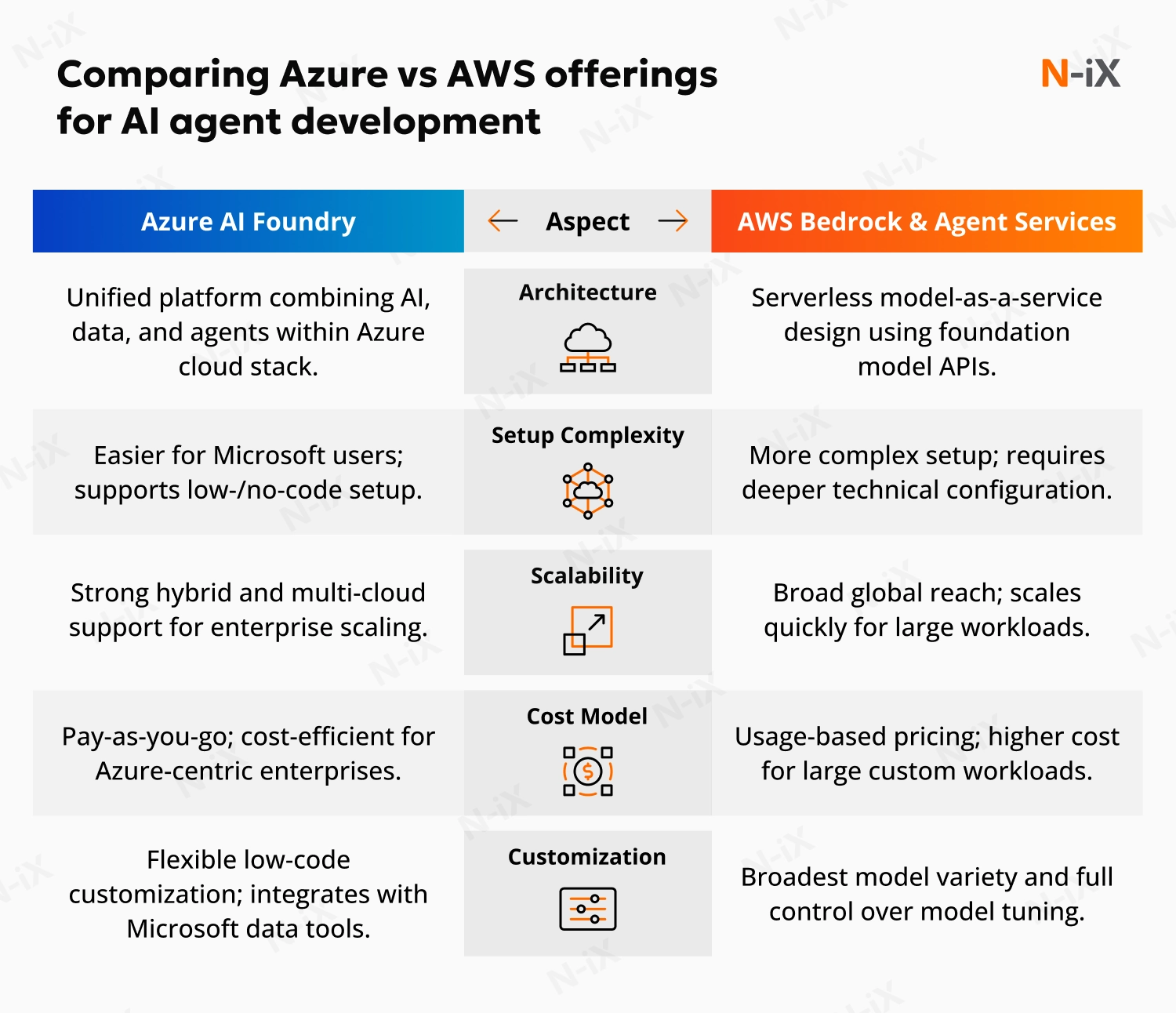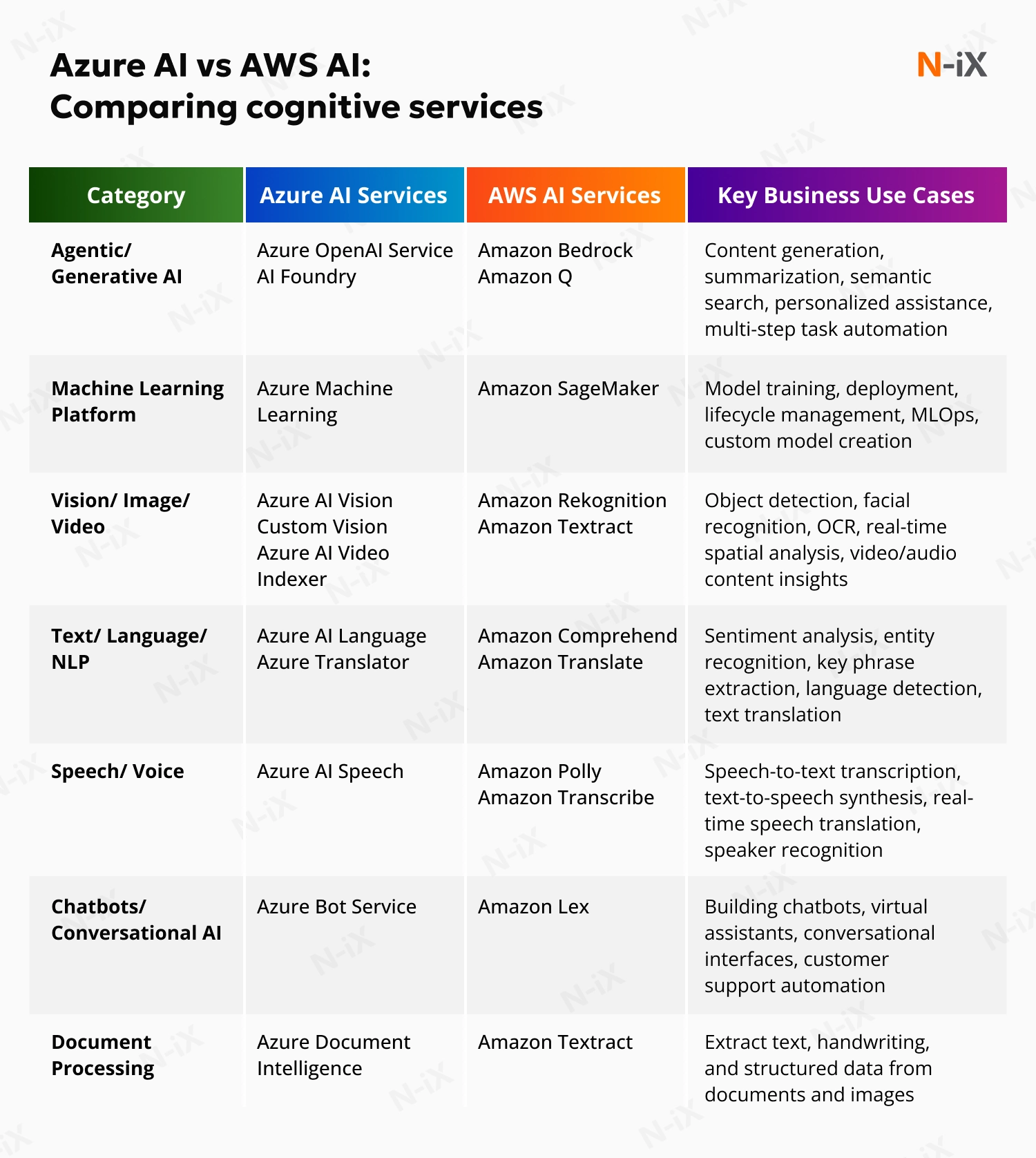As businesses continue expanding their AI capabilities, one question remains: which cloud provider delivers more value for AI innovation? In 2025, AWS continues to lead the global cloud market with about 30% share, while Microsoft Azure holds around 20% [1]. Yet, in fiscal Q4 2025, Azure's revenue hit 39% year-over-year growth, the highest among cloud providers. One of the primary drivers of the surge was the massive demand for Azure AI services [2].
While both tech giants offer powerful AI ecosystems, choosing between them can be challenging. Should your business leverage AWS for its unmatched scalability and model diversity, or Azure for its enterprise-grade integration and simplified AI deployment?
In this article, we compare Azure vs AWS AI offerings and highlight key differences to help you make an informed choice for intelligent cloud solutions.
Azure vs AWS AI: Cognitive Services
AWS and Microsoft Azure offer a wide range of cognitive services to help businesses build AI-powered cloud applications and gain insights from data. We asked our top cloud and AI experts to compare the key offerings from both platforms.
Machine Learning
Azure Machine Learning is an intelligent cloud service that simplifies the entire ML lifecycle. It offers tools for training and deploying models, managing MLOps, and creating custom workflows. Azure supports open-source frameworks like PyTorch and TensorFlow and provides a low-code option for developers through the AutoML interface.
AWS SageMaker, on the other hand, provides an end-to-end cloud solution for Machine Learning model development. It includes SageMaker Studio for unified IDE access, SageMaker Autopilot for automatic model creation, and SageMaker Pipelines for creating ML workflows.
While Azure is more suitable for enterprises looking for streamlined integration, AWS provides more granular control and scalability for complex ML tasks.
Generative AI and agentic AI
Azure's OpenAI Service gives businesses direct access to 11354 AI models, including the GPT series, Claude, DeepSeek, DALL-E, etc. These models help complete diverse generative tasks, including content generation, summarization, and natural language-to-code translation. Azure also offers the AI Foundry platform for building and deploying GenAI and agentic AI applications, supporting responsible model deployment.
AWS offers Amazon Bedrock, a fully managed service that aggregates various foundation models (FMs) from top AI firms such as AI21 Labs, Anthropic, and Cohere. This flexibility allows businesses to tailor models to their specific data and needs, enhancing custom AI development. Amazon Q, AWS's generative AI assistant, integrates with enterprise systems to perform multi-step tasks and automate content generation.
While Azure focuses on providing unified, compliant experiences, AWS provides a greater variety of models and customization options for building GenAI applications.

Text operations and NLP
Azure AI Language includes a suite of NLP services, such as sentiment analysis, entity recognition, and key phrase extraction. The Azure Translator service provides real-time language translation and offers customizable translation options for businesses.
AWS also provides a comprehensive NLP service with Amazon Comprehend, which can identify entities, perform sentiment analysis, and detect key phrases in text. Additionally, Amazon Translate offers fast and high-quality neural machine translations for over 75 languages. For conversational experiences, Amazon Lex helps develop chatbots with integrated natural language understanding (NLU) and automated speech recognition (ASR) capabilities. This enables businesses to deliver engaging and interactive user experiences.
When comparing AWS AI vs Azure AI by NLP capabilities, it is important to mention that Azure is better suited for building more specialized, custom language models. At the same time, AWS excels in large-scale, high-quality text processing, making it ideal for businesses with large multilingual needs.
Image and video
Azure AI Vision and Custom Vision offer image recognition and classification, including object detection and optical character recognition (OCR) for printed and handwritten text. Azure AI Video Indexer further enhances this by providing deep insights into videos, including content search, moderation, accessibility features, and monetization.
AWS provides Amazon Rekognition, a powerful service for image and video analysis. It is trained to detect objects, people, text, and even perform facial analysis to verify emotions or identity.
While Azure provides more advanced video analysis features, AWS excels in real-time facial recognition and content moderation, making it more suited for security and compliance applications.
Speech and voice
Azure AI Speech includes a comprehensive suite of services, including highly accurate speech-to-text transcription, text-to-speech synthesis with natural-sounding voices, and real-time speech translation. Azure also supports speaker recognition, allowing businesses to authenticate users based on their voice.
AWS offers Amazon Polly, a text-to-speech service with a wide selection of lifelike voices across different languages. Amazon Transcribe offers real-time and batch transcription, making it suitable for applications like live customer support and medical transcriptions. Transcribe also supports specialized versions for healthcare and contact centers.
If you are deciding between AWS vs Azure AI for speech and voice processing, our experts recommend Azure for advanced real-time speech translation and speaker recognition. AWS, at the same time, fits better for voice synthesis and large-scale transcription use cases.
Chatbots and conversational AI
Azure Bot Service enables businesses to develop chatbots that understand conversational language. This service is ideal for enterprises looking to build intelligent virtual assistants and customer service bots, with seamless integration into Microsoft's ecosystem.
AWS provides Amazon Lex, which enhances conversational interfaces and chatbots using the same technology as Alexa. It supports text and voice interactions and integrates seamlessly with other AWS services, helping create scalable and flexible chatbot solutions.
While both platforms offer advanced capabilities, AWS Lex provides more flexibility for building custom conversational experiences.
Document processing
Azure Document Intelligence helps businesses extract data from documents and forms, enabling intelligent processing of large datasets. It supports various document types and offers insights into business operations to improve decision-making.
AWS Textract goes beyond traditional OCR to automatically extract text and data from scanned documents. It is designed to automate data entry and processing, support various document types, and provide highly accurate results.
The Azure vs AWS AI comparison highlights that AWS offers broader features for automating document workflows. At the same time, Azure provides a more integrated solution for businesses aiming to build intelligent document processing pipelines.

Azure AI vs AWS AI: 5 core differences
Besides technological comparison, let's see how Azure and AWS services differ in business terms and ease of usage. N-iX consultants recommend considering these criteria to find the right cloud for your AI workloads:
1. Ease of use
AWS AI's ecosystem can be complex for new users because of the extensive array of tools and configurations. However, it offers tutorials and documentation that ease the learning curve. Azure AI provides a more user-friendly interface and seamless integration with Microsoft's existing cloud infrastructure, which may be more appealing for enterprises looking for a smoother experience.
2. Customization and flexibility
When comparing AWS vs Azure for AI customization, you should consider that AWS provides a broader range of ML algorithms and more granular adjustment options. At the same time, Azure focuses more on pre-configured, enterprise-friendly solutions that require less setup.
This focus on streamlined, production-grade AI made Azure the right fit for one of N-iX's logistics clients seeking to modernize their platform. Tailored ML models for predictive analytics and Computer Vision algorithms from Azure enabled our developers to optimize their supply chain operations. This helped our client automate manual work, streamline inventory management, track packages almost in real-time, and detect damaged parcels.
Read the full case here: Driving logistics efficiency with industrial Machine Learning
3. Pricing
Azure and AWS offer competitive pricing, but Azure often presents better value for businesses already embedded in the Microsoft ecosystem. AWS provides a larger pool of AI tools, which might justify the cost for more complex applications.
4. Ecosystem integration
Azure benefits from its deep integration with Microsoft's software, including Office 365, Dynamics, and Windows Server, making it a preferable choice for organizations heavily reliant on these products. On the other hand, AWS provides tight interoperability with third-party services and a more expansive global reach.
This flexibility often makes AWS the preferred option for companies operating large, data-driven platforms or relying on diverse external integrations. For example, N-iX helped a media company build an AI-powered solution on AWS to analyze competitors' content and identify emerging trends. The firm operated a large online platform and aimed to expand its audience by delivering more relevant content based on the latest trends. Our development team selected the AWS ecosystem for its advanced data analytics, seamless integration with existing third parties, and global reach. The new solution enabled the company to grow its audience by delivering engaging content and quickly adapting to emerging trends.
5. Performance and scalability
AWS AI is renowned for its scalability and the performance of its machine learning services. Its broad network of data centers ensures low-latency access worldwide. Azure also provides solid scalability but is often better suited for businesses that prioritize tightly integrated, hybrid cloud solutions.
Azure vs AWS for AI: Expert verdict
Though AWS and Azure AI services are similar, they have some differences that can impact the success of your AI initiatives. The decision between the two providers depends on your specific infrastructure requirements, the type of AI solutions you need, and your overall business objectives.
Choose AWS if you need:
- Advanced customization and have complex AI requirements;
- Comprehensive machine learning and generative AI offerings;
- More scalable infrastructure and global reach.
Choose Azure if you have further requirements:
- Seamless integration with the Microsoft ecosystem;
- More user-friendly experience with low-code/no-code capabilities;
- Hybrid cloud systems to deploy AI solutions on-premises and in the cloud.
Developing, training, and deploying a cloud-based AI solution without expert assistance can be challenging. Thus, enterprises often partner with experienced cloud consultants for technological and business support. Skilled professionals can help tailor AI solutions to your specific needs, ensure smooth integration with existing infrastructure, accelerate time to market, and optimize costs. Whether you choose Azure vs AWS AI, collaborating with a consultant provides a more effective deployment, allowing you to leverage the intelligent cloud capabilities.
How can N-iX help?
At N-iX, we help organizations navigate the complexities of AI and cloud adoption. As an AWS Premier Tier Services Partner and Microsoft Solutions Partner, we have proven expertise across both cloud ecosystems.
Our team of over 400 cloud experts combines deep technical knowledge with practical experience in AI, data, and ML to accelerate innovation and modernization initiatives. Over the past five years, N-iX has successfully delivered more than 100 cloud projects and 60 AI and data solutions, delivering measurable business outcomes.
Partner with N-iX to turn your AI vision into innovative solutions, ensure smooth cloud adoption, and accelerate your organization's digital transformation journey.
References
- Statista - The Big Three Stay Ahead in Ever-Growing Cloud Market
- Cloud wars - Microsoft Q4 Blowout: Nadella Breaks Down Azure's 39% Growth
Have a question?
Speak to an expert




